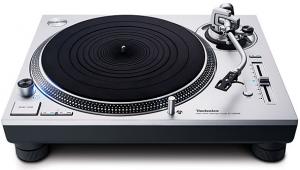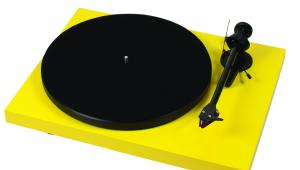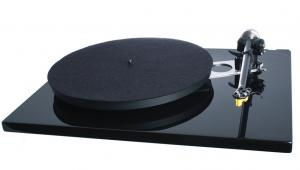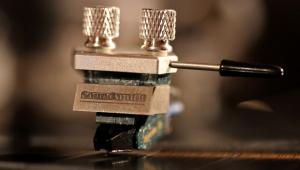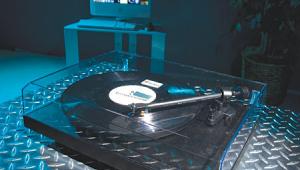The value for wow and flutter, ±0.25%, seems a little high for a turntable in this price range -- the cheaper Pro-Ject Debut III comes in at about half that. And there is no S/N ratio spec.
Sony PS-HX500 Hi-Res USB Turntable Review
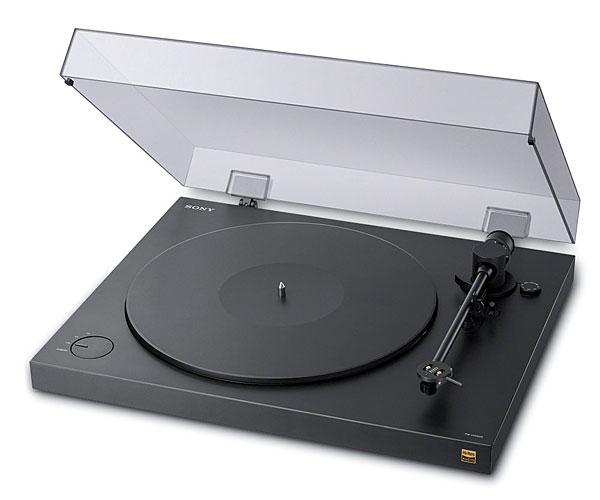
AT A GLANCE
Plus
Good-quality manual belt-drive turntable
Built-in hi-res analog-to-digital converter
Built-in phono preamp
Simple user setup
Minus
Additional software needed to play recorded files
Manual metadata collection for recorded files
THE VERDICT
With analog and hi-res digital outputs, and a built-in phono preamp, the Sony PS-HX500 has what you need to bring your vinyl collection into the 21st century digital world.
Detractors love to say that the current resurgence of vinyl is nothing but a bunch of bearded hipsters with Crosley Cruisers, trying to look cool in their mid-century bachelor pads. There is, however, one surefire way to tell the difference between a fad and a real movement, and that’s when the big boys stop snickering from the sidelines and decide to start playing along.
Most of the big consumer electronics companies dropped out of the turntable business decades ago, but suddenly in the last year we have seen ambitious new turntable introductions from big players like Onkyo, Pioneer, Technics, and now Sony. Most of these new offerings look like they could have come straight from the manufacturers’ 1989 catalogs, but Sony’s latest vinyl spinner, the PS-HX500, has one foot planted firmly in the 21st century. Decent-quality turntables with a digital output have been around for quite a few years—my colleague Mark Fleischmann reported on a USB version of the Pro-Ject Debut back in 2008. But this one is definitely the first that can spit out both high-resolution DSD and PCM digital signals.
DSD or Direct Stream Digital is the digital signal format used for Super Audio CDs (SACD) and is fundamentally different from the more common PCM signal used for CDs and most other forms of digital audio recording. Debating the merits of DSD versus PCM is beyond the scope of this review, and it’s a moot point anyway, because in addition to DSD, the PS-HX500 can also deliver PCM signals in various quality levels all the way up to 192-kilohertz/24-bit high resolution.
Connect the PS-HX500 to a computer running its companion Hi-Res Audio Recorder software for Windows or Mac OS X, and you can turn your records into digital files that you can play on your audio system or take with you on the road in a personal music player. That’s a whole lot easier than lugging a portable record player and a pile of hip vinyl around with you.
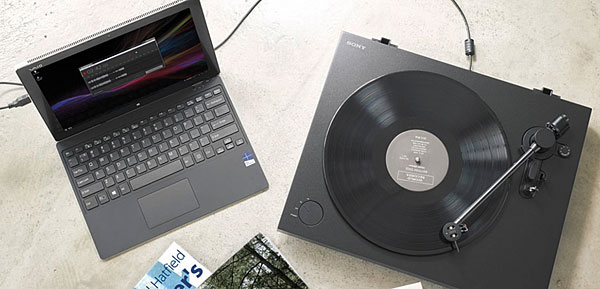
Of course, the basic appeal of vinyl is its ability to bring us back to a pure analog world, so naturally, the PS-HX500 can also function as a standard analog turntable delivering either a cartridge level signal that you can connect to your phono preamp– equipped amplifier, or through its own built-in phono preamp at line level. You can even connect both the digital and analog outputs simultaneously, allowing you to record your records onto a computer while listening to them through your hi-fi system.
Setup
If you went back some 35 years to a time when turntables still ruled the audio world, you’d discover that
you could go to your local hi-fi emporium, pick out a turntable and cartridge, and the resident turntable guru would put it all together and align it for you. More recently, turntable manufacturers have realized that most people these days buy their turntables online, and most of us don’t have a friendly analog expert to help us out. The upshot is that any sub-$1,000 turntable really needs to be pretty easy for even a novice to put together correctly.
The PS-HX500 achieves this by arriving with a pre-installed moving-magnet cartridge that’s already fully aligned and ready to go. Out of the box, all you have to do is install the platter while looping the rubber drive belt around the motor pulley and then top it off with its thick rubber mat. For the tonearm, you just put on the counterweight, balance the arm, and dial in the tracking force. The manual takes you through the steps if you’re not familiar with the process, but it’s designed so you can’t go too far wrong. Finally, you plug in the wall-wart power supply and audio output cables, and you’ll be ready to go. I double-checked the alignment of the cartridge and can report that it was installed perfectly, with absolutely spot-on overhang and zenith. The tracking force readout was accurate, and the anti-skating control dialed in the correct amount of bias.
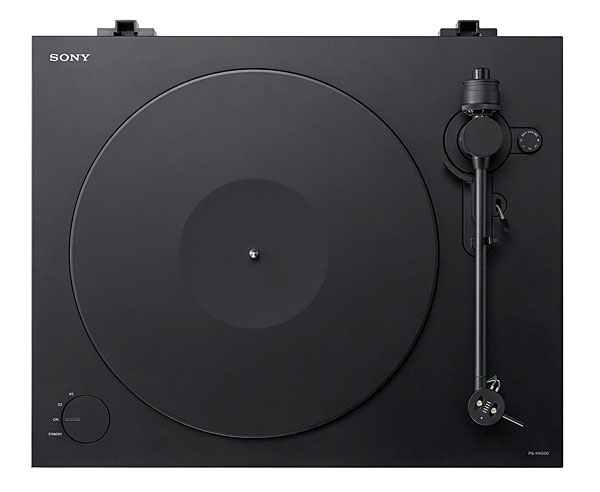
The underlying structure or plinth of the PS-HX500 takes a page from many of the budget turntables from small specialist manufacturers. It’s a 11/8-inch slab of medium density fiberboard (MDF) onto which the platter bearing, motor, and tonearm are attached. In the past when Sony was selling turntables by the boatload, it made sense to create a special molded chassis for each model so they could crank them out. Using an MDF plinth works out better for smaller production runs, and besides, it offers better vibration damping and performance. To further enhance this vibration control, the plinth is supported on four squishy rubber damping feet.
The motor is a small DC unit that’s compliantly mounted into the plinth, and it drives a die-cast aluminum platter. At around 18 ounces, the platter does feel a bit lightweight, although the thick rubber mat weighs almost as much as the platter itself, bringing the total platter weight up to around 2 pounds. The platter sits slightly recessed into the plinth, giving the PS-HX500 a sleek, low-profile appearance.
Because it’s a completely man- ual turntable, the controls on the PS-HX500 are very simple. A four-way switch has Standby, On, 33, and 45 positions, which means you can keep the electronics powered up while you turn off the motor to change records. Without this feature, the turntable would switch off its analog-to-digital converter each time you wanted to change the record, thereby unlocking it from the recording software running on your computer.
- Log in or register to post comments

Thanks for reviewing this turntable. When Sony announced the PS-HX500 turntable at CES 2016, I was intrigued by its ability to record DSD and PCM digital signals. I would like to convert some of my vinyl to FLAC 24/96 and transfer the songs to my Sony HAP-S1 player.
Sound and Vision:
- What is the physical size of the wall-wart power supply?
- Does the turntable stay powered at all times? No power "Off" switch?
- Are the four squishy rubber damping feet adjustable for leveling the turntable?
- What is the real difference between "On" and "Standby" settings?
- What is the phono preamp output? 2.5mV?
- What is the line output? 150 mV?
- I am under the impression the generic cartridge is supplied by Audio Technica. I cannot find any cartridge in the Audio Technica line-up that has a 2.5 mV output. Do you know the specific cartridge that is supplied with this turntable?
- The generic cartridge appears to be an Audio Technica CN5625AL or some variant because this is the only cartridge in their lineup that tracks between 1.5-3.0 grams (but it has an output of 4.2mV at 1kHz). Can I replace the supplied cartridge with an Audio Technica AT440MLb? (The AT440MLb tracks between 1-1.8 grams and has an output of 4.0mV at 1kHz).
- Does Sony supply an overhand gauge? If not, how does one adjust the
overhang on this turntable? Does Sony provide instructions for this?
- Does Sony's Hi-Res Audio Recorder Software work with Windows 8.1 and Windows 10?
- Do you know why the turntable's digital output is designed to only interface with Sony's Hi-Res Audio Recorder Software (besides obvious
vendor lock-in)?
- Do you know why the Hi-Res Audio Recorder Software does not employ noise reduction or a way to adjust volume for PCM? (Seems odd that you can't perform basic stuff using one software package).
- Did you measure the quietness of the turntable? If so, what the signal-to-noise ratio?
- Is the measured wow and flutter acceptable? Can it be adjusted?
- If you used this turntable to digitize records, what bit rate/sampling size would you recommend? 16/44? 24/48? 24/96?
I look forward to your responses.
Sony:
Based on my understanding of this review, I offer the following suggestions for strengthening this product offering:
- After product launch, immediately release an updated version of the Hi-Res Audio Recorder software with native playback and noise reduction capabilities, and/or
- Update Sound Forge Audio Studio to interface with the turntable, thus reducing the chance of an orphaned product in the near future, and/or
- Allow third party software to interface with the USB digital output (again reducing the chance of an orphaned product in the near future).
- Provide suggestions for other cartridges that are compatible with this turntable. Please be specific with vendor names and model numbers.

Here's the full specs: https://docs.sony.com/release//specs/PSHX500_mksp.pdf

All you need to do is attach the platter straight from the box, encircling the motor arborist hamilton pulley with the rubber drive belt, and cover it with the thick rubber mat.

Dzień dobry. Czy chcesz uzyskać wysokiej jakości usługi modelowania 3D? Radzę skorzystać z tego serwisu https://freelancehunt.com/pl/freelancers/design-sztuka/tworzenie-modeli , ponieważ tutaj znajdziesz portfolio różnych influencerów, którzy mogą pomóc Ci w realizacji Twoich projektów. Po przeanalizowaniu portfolio każdego specjalisty będziesz mógł wybrać najlepszego dla swoich potrzeb.

Yet again good to visit your blog, it has been a long time for me. Well this article that ive been hung tight for hence lengthy. I maintain that this article should complete my task inside the personnel, and it has same point along with your article. Much appreciated, decent offer. Claydence

I will understand this. I'll make certain to return. gratitude for sharing. and furthermore This article gives the light in which we can notice the truth. this is extremely pleasant one and gives indepth data. gratitude for this decent article... get a gift

Much thanks for composing such a fascinating article on this theme. This has truly made me think and I desire to understand more. خرید قلاده سگ

It's impressive how South Africans bring their teaching styles to classrooms in Korea. South Africans teach english in Korea

เสื้อลายดอก , เสื้อคู่ , เสื้อเชิ้ตคนตัวใหญ่ , เสื้อLGBT, เสื้อสงกรานต์ , เสื้อฮาวาย , เสื้อทีม , เสื้อบริษัท , เสื้อปาร์ตี้ , เสื้อใส่เที่ยวทะเล ครบสี ครบไซต์ ทำให้ซื้อไปใส่เป็นทีมใหญ่ หรือ กลุ่มใหญ่ โดยไม่ต้องสั่งตัดแพงๆ ใส่ได้ทั้งผู้ชาย และ ผู้หญิง ดีไซน์ทันสมัย เนื้อผ้าสวมใส่สบาย เหมาะสำหรับการ ทุกฤดูกาล ใส่ได้หลากหลายโอกาส เช่น เที่ยวทะเล ทำบุญ สรงน้ำพระพุทธรูปที่บ้าน รดน้ำดำหัวผู้ใหญ่ในบ้าน สีสันสดใส ใส่สบาย มีหลากหลาย ขนาด สไตล์ สี และ ลวดลายให้เลือกสรร เราคัดสรรที่ดีที่สุดมาให้แล้ว ขายดีอันดับ 1 การันตีจากเสียงลูกค้าที่บอกต่อเยอะมาก เสื้อLGBT

Much gratitude to you benevolent for such a luxuriously made article. It's stacked with splendid data. Your perspective is perfect among different without fail.For certain, It is perhaps of the best blog according to my point of view. quantum rox platform

I truly like your interpretation of the issue. I before long have a reasonable thought on what's truly going on with this.. 8@BT Showflat

Grateful to you a pack for giving this to us all you genuinely perceive what you are suggesting! Bookmarked. Accepting nobody minds, besides look for request from my site =). We could have a hyperlink change contract between us! French language

Crystal-clear audio can make or break an event, and that’s why finding the right -ound Equipment Rental service is essential https://rentforevent.com/orl/audio-sound-rentals/ . Whether it's a corporate conference, a wedding, a live concert, or a private party, high-quality sound ensures that every word, note, and effect reaches the audience exactly as intended. Too often, people underestimate the impact of professional-grade audio, only to struggle with muffled speeches, distorted music, or uneven volume levels.A reliable -ound Equipment Rental provider offers more than just speakers and microphones. The best services provide a full range of options, including mixers, amplifiers, subwoofers, and wireless setups to meet the specific needs of any venue or occasion. Professional setup and on-site support can also be game-changers, preventing last-minute technical difficulties that could disrupt an event.

A well-built concrete patio adds value and functionality to your home. Contact a professional concrete contractor for high-quality installation.



